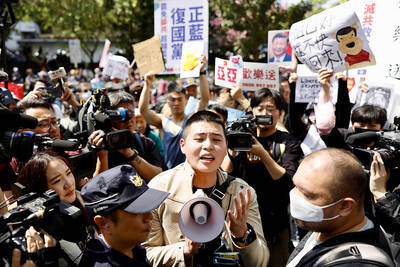Chinese central bank Governor Zhou Xiaochuan (周小川) said that local-government financing vehicles using land as collateral may pose risks for the nation’s banks.
“When land prices rise, there may be over-valuation of land,” Zhou said at a press briefing in Beijing yesterday. “In the future, if land prices fall, there may be a difference in the assessment of the loan.”
China’s local governments are raising funds through investment vehicles to circumvent regulations that prevent them borrowing directly. The extra borrowing, not counted in official calculations, could lead to debt rising to 96 percent of GDP ratio next year and in “the worst case” trigger a financial crisis, Northwestern University professor Victor Shih (史宗瀚) said last week.
Zhou said that while “many” local financing vehicles have the ability to repay, two types cause concern. One uses land as collateral, while the other can’t fully repay borrowing, meaning that the local governments may be liable, leading to “fiscal risks.”
The central bank will ensure lenders comply with regulations on evaluating loans, pricing risk and assessing the value of land, Zhou said, adding that they “should be prudent, meaning a bit conservative.”
Shih said that China needs to stop new projects funded by the local government entities and estimates that their borrowing so far may result in bad loans of up to 3 trillion yuan (US$439 billion).
Jonathan Anderson, an economist for UBS AG, said on Saturday that he saw a “classic red herring” in arguments that “enormous, hidden off-balance-sheet liabilities” of China’s local governments could precipitate a debt crisis.
China’s explosion of credit hasn’t been accompanied by, for example, the derivative exposures and short-term borrowing from abroad that were factors in past crises in China and the US, he said in an e-mailed report.
The use of local-government financing vehicles is a “micro-level” question, not one that affects judgments on the strength of a Chinese economy which is “nowhere near to a crisis or implosion,” Anderson said.
China will control new investment projects and urge local governments to avoid expanding investments “blindly, beyond their abilities,” said Zhang Ping (張平), head of the National Development and Reform Commission, China’s top economic planning agency.
“If not properly dealt with, such borrowing may bring about potential fiscal and financial risks,” Zhang said at yesterday’s briefing.
The finance ministry is mulling measures to ensure that local governments make rational decisions based on their fiscal revenues, Zhang said.
“We will strengthen monitoring and limit lending to high energy consuming or polluting projects or those in industries with over-capacity,” he said.
Chinese Finance Minister Xie Xuren (謝旭人) pledged at the same briefing to increase oversight of fund-raising by local governments and guard against “latent” risks. Increased regulation is needed “to support the healthy development of the economy,” he said.
Chinese officials allowed lending to explode from late 2008 to fight off the effects of the global financial crisis, with new loans rising to a record 9.59 trillion yuan last year.

ENDEAVOR MANTA: The ship is programmed to automatically return to its designated home port and would self-destruct if seized by another party The Endeavor Manta, Taiwan’s first military-specification uncrewed surface vehicle (USV) tailor-made to operate in the Taiwan Strait in a bid to bolster the nation’s asymmetric combat capabilities made its first appearance at Kaohsiung’s Singda Harbor yesterday. Taking inspiration from Ukraine’s navy, which is using USVs to force Russia’s Black Sea fleet to take shelter within its own ports, CSBC Taiwan (台灣國際造船) established a research and development unit on USVs last year, CSBC chairman Huang Cheng-hung (黃正弘) said. With the exception of the satellite guidance system and the outboard motors — which were purchased from foreign companies that were not affiliated with Chinese-funded

PERMIT REVOKED: The influencer at a news conference said the National Immigration Agency was infringing on human rights and persecuting Chinese spouses Chinese influencer “Yaya in Taiwan” (亞亞在台灣) yesterday evening voluntarily left Taiwan, despite saying yesterday morning that she had “no intention” of leaving after her residence permit was revoked over her comments on Taiwan being “unified” with China by military force. The Ministry of the Interior yesterday had said that it could forcibly deport the influencer at midnight, but was considering taking a more flexible approach and beginning procedures this morning. The influencer, whose given name is Liu Zhenya (劉振亞), departed on a 8:45pm flight from Taipei International Airport (Songshan airport) to Fuzhou, China. Liu held a news conference at the airport at 7pm,

AIR SUPPORT: The Ministry of National Defense thanked the US for the delivery, adding that it was an indicator of the White House’s commitment to the Taiwan Relations Act Deputy Minister of National Defense Po Horng-huei (柏鴻輝) and Representative to the US Alexander Yui on Friday attended a delivery ceremony for the first of Taiwan’s long-awaited 66 F-16C/D Block 70 jets at a Lockheed Martin Corp factory in Greenville, South Carolina. “We are so proud to be the global home of the F-16 and to support Taiwan’s air defense capabilities,” US Representative William Timmons wrote on X, alongside a photograph of Taiwanese and US officials at the event. The F-16C/D Block 70 jets Taiwan ordered have the same capabilities as aircraft that had been upgraded to F-16Vs. The batch of Lockheed Martin

GRIDLOCK: The National Fire Agency’s Special Search and Rescue team is on standby to travel to the countries to help out with the rescue effort A powerful earthquake rocked Myanmar and neighboring Thailand yesterday, killing at least three people in Bangkok and burying dozens when a high-rise building under construction collapsed. Footage shared on social media from Myanmar’s second-largest city showed widespread destruction, raising fears that many were trapped under the rubble or killed. The magnitude 7.7 earthquake, with an epicenter near Mandalay in Myanmar, struck at midday and was followed by a strong magnitude 6.4 aftershock. The extent of death, injury and destruction — especially in Myanmar, which is embroiled in a civil war and where information is tightly controlled at the best of times —